Numerical Simulation and Consequence Analysis of Full-Scale Jet Fires for Pipelines Transporting Pure Hydrogen or Hydrogen Blended with Natural Gas
Abstract
1. Introduction
2. Methodology
2.1. Equivalent Pipe Leakage Model
2.2. Verification of High-Pressure Gas Transient Leakage Model
2.3. Verification of Equivalent Pipe Leakage Model
3. Numerical Modeling
3.1. Jet Fire Model
3.2. Turbulence Model
3.3. Combustion Model
3.4. Radiation Model
4. Results and Discussion
4.1. Flame Height
4.2. Flame Appearance
4.3. Thermal Radiation
4.4. Hazard Distance of Thermal Radiation
5. Conclusions
Author Contributions
Funding
Institutional Review Board Statement
Informed Consent Statement
Data Availability Statement
Conflicts of Interest
Nomenclature
| A | Leakage area (m2) |
| b | Correction coefficient of gas specific volume (m3/kg) |
| Cd | Discharge coefficient |
| d | Diameter (m) |
| m | Gas mass (kg) |
| Gas mass flow rate (kg/s) | |
| P | Gas absolute pressure (Pa) |
| Gas constant (J/(kg·K)) | |
| T | Gas thermodynamic temperature (K) |
| u | Gas flow velocity (m/s) |
| v | Gas specific volume (m3/kg) |
| Critical pressure ratio | |
| Time (s) | |
| Velocity components in x-direction (m/s) | |
| Physical coordinate in x-direction | |
| Physical coordinate in y-direction | |
| Turbulence kinetic energy (m2/s2) | |
| Contribution of the fluctuating dilatation in compressible turbulence to the overall dissipation rate | |
| Turbulent kinetic energy generation term due to the mean velocity gradient | |
| Turbulence kinetic energy generation term due to buoyancy | |
| Source term | |
| Constant = 1.42 | |
| Constant = 1.68 | |
| Constant | |
| Mass fraction (%) | |
| Mixture fraction (%) | |
| Mixture velocity (m/s) | |
| Thermal conductivity (W/(m·K)) | |
| Specific heat capacity (J/(kg·K)) | |
| Radiation flux (kW/m2) | |
| Parameter in Equation (28) | |
| Incident radiation (kW/m2) | |
| Linear-anisotropic phase function coefficient | |
| Refractive index of the medium (cm−1) | |
| Absorption coefficient (cm−1) | |
| Distance from the flame center line (m) | |
| Height from the ground (m) | |
| Heat release rate (MW) | |
| Greek symbols | |
| Gas density (kg/m3) | |
| Specific heat ratio | |
| Turbulence eddy dissipation (m2/s3) | |
| Scattering coefficient (cm−1) | |
| Stefan–Boltzmann constant = 5.67 × 10−8 (W/(m2·K4)) | |
| Turbulent viscosity (kg/(m·s)) | |
| Prandtl number | |
| Inverse effective Prandtl number | |
| dynamic viscosity (Pa·s) | |
| Subscripts | |
| Ambient gas condition | |
| i | Iteration |
| 0 | Initial |
| 1 | Gas state inside the pipe |
| 2 | Gas state at the real leakage outlet |
| 3 | Gas state at the notional nozzle |
| Component | |
| Oxidant inlet | |
| Mixture | |
| User-defined | |
| Fuel inlet | |
References
- Al-Breiki, M.; Bicer, Y. Comparative life cycle assessment of sustainable energy carriers including production, storage, overseas transport and utilization. J. Clean. Prod. 2021, 279, 123481. [Google Scholar] [CrossRef]
- Olabi, A.G.; Abdelkareem, M.A. Renewable energy and climate change. Renew. Sust. Energ. Rev. 2022, 158, 112111. [Google Scholar] [CrossRef]
- Li, Y.; Kuang, Z.; Fan, Z.; Shuai, J. Evaluation of the safe separation distances of hydrogen-blended natural gas pipelines in a jet fire scenario. Int. J. Hydrogen Energy 2023, 48, 18804–18815. [Google Scholar] [CrossRef]
- Olabi, A.G.; Abdelkareem, M.A.; Mahmoud, M.S.; Elsaid, K.; Obaideen, K.; Rezk, H.; Wilberforce, T.; Eisa, T.; Chae, K.-J.; Sayed, E.T. Green hydrogen: Pathways, roadmap, and role in achieving sustainable development goals. Process Saf. Environ. Protect. 2023, 177, 664–687. [Google Scholar] [CrossRef]
- Renssen, S.V. The hydrogen solution? Nat. Clim. Chang. 2020, 10, 799–801. [Google Scholar] [CrossRef]
- Global Hydrogen Review 2022; IEA: Paris, France, 2022.
- Ma, N.; Zhao, W.; Wang, W.; Li, X.; Zhou, H. Large scale of green hydrogen storage: Opportunities and challenges. Int. J. Hydrogen Energy 2024, 50, 379–396. [Google Scholar] [CrossRef]
- Su, Y.; Li, J.; Yu, B.; Zhao, Y. Numerical investigation on the leakage and diffusion characteristics of hydrogen-blended natural gas in a domestic kitchen. Renew. Energ. 2022, 189, 899–916. [Google Scholar] [CrossRef]
- Chen, X.; Zhang, C.; Li, Y. Research and development of hydrogen energy safety. Emerg. Manag. Sci. Technol. 2022, 2, 3. [Google Scholar] [CrossRef]
- Wang, Z.; Zhou, K.; Zhang, L.; Nie, X.; Wu, Y.; Jiang, J.; Dederichsc, A.S.; He, L. Flame extension area and temperature profile of horizontal jet fire impinging on a vertical plate. Process Saf. Environ. Protect. 2021, 147, 547–558. [Google Scholar] [CrossRef]
- Wang, C.; Zhang, L.; Tao, G. Quantifying the influence of corrosion defects on the failure prediction of natural gas pipelines using generalized extreme value distribution (GEVD) model and Copula function with a case study. Emerg. Manag. Sci. Technol. 2024, 4, e003. [Google Scholar] [CrossRef]
- Schefer, R.W.; Houf, W.G.; Williams, T.C.; Bourne, B.; Colton, J. Characterization of high-pressure, underexpanded hydrogen-jet flames. Int. J. Hydrogen Energy 2007, 32, 2081–2093. [Google Scholar] [CrossRef]
- Acton, M.R.; Allason, D.; Creitz, L.W.; Lowesmith, B.J. Large scale experiments to study hydrogen pipeline fires. In Proceedings of the 2010 8th International Pipeline Conference, Calgary, AB, Canada, 27 September–1 October 2010; pp. 593–602. [Google Scholar]
- Proust, C.; Jamois, D.; Studer, E. High pressure hydrogen fires. Int. J. Hydrogen Energy 2011, 36, 2367–2373. [Google Scholar] [CrossRef]
- Lowesmith, B.J.; Hankinson, G. Large scale high pressure jet fires involving natural gas and natural gas/hydrogen mixtures. Process Saf. Environ. Protect. 2012, 90, 108–120. [Google Scholar] [CrossRef]
- Lowesmith, B.J.; Hankinson, G. Large scale experiments to study fires following the rupture of high pressure pipelines conveying natural gas and natural gas/hydrogen mixtures. Process Saf. Environ. Protect. 2013, 91, 101–111. [Google Scholar] [CrossRef]
- Wu, L.; Kobayashi, N.; Li, Z.; Huang, H.; Li, J. Emission and heat transfer characteristics of methane–hydrogen hybrid fuel laminar diffusion flame. Int. J. Hydrogen Energy 2015, 40, 9579–9589. [Google Scholar] [CrossRef]
- Hooker, P.; Hall, J.; Hoyes, J.R.; Newton, A.; Willoughby, D. Hydrogen jet fires in a passively ventilated enclosure. Int. J. Hydrogen Energy 2017, 42, 7577–7588. [Google Scholar] [CrossRef]
- Xiao, J.; Kuznetsov, M.; Travis, J.R. Experimental and numerical investigations of hydrogen jet fire in a vented compartment. Int. J. Hydrogen Energy 2018, 43, 10167–10184. [Google Scholar] [CrossRef]
- Tang, Z.; Wang, Z.; Zhao, K. Flame extension length of inclined hydrogen jet fire impinging on a water curtain. J. Loss Prev. Process Ind. 2023, 83, 105059. [Google Scholar] [CrossRef]
- Zhao, C.; Li, X.; Wang, X.; Li, M.; Xiao, H. An experimental study of the characteristics of blended hydrogen-methane non-premixed jet flames. Process Saf. Environ. Protect. 2023, 174, 838–847. [Google Scholar] [CrossRef]
- Yu, X.; Wang, C.J.; He, Q.Z. Numerical study of hydrogen dispersion in a fuel cell vehicle under the effect of ambient wind. Int. J. Hydrogen Energy 2019, 44, 22671–22680. [Google Scholar] [CrossRef]
- Markert, F.; Melideo, D.; Baraldi, D. Numerical analysis of accidental hydrogen releases from high pressure storage at low temperatures. Int. J. Hydrogen Energy 2014, 39, 7356–7364. [Google Scholar] [CrossRef]
- Cleaver, R.P.; Halford, A.R. A model for the initial stages following the rupture of a natural gas transmission pipeline. Process Saf. Environ. Protect. 2015, 95, 202–214. [Google Scholar] [CrossRef]
- Liu, J.; Fan, Y.; Zhou, K.; Jiang, J. Prediction of flame length of horizontal hydrogen jet fire during high-pressure leakage process. Procedia Eng. 2018, 211, 471–478. [Google Scholar] [CrossRef]
- Zhou, K.; Liu, J.; Wang, Y.; Liu, M.; Yu, Y.; Jiang, J. Prediction of state property, flow parameter and jet flame size during transient releases from hydrogen storage systems. Int. J. Hydrogen Energy 2018, 43, 12565–12573. [Google Scholar] [CrossRef]
- Zhou, K.; Wang, X.; Liu, M.; Liu, J. A theoretical framework for calculating full-scale jet fires induced by high-pressure hydrogen/natural gas transient leakage. Int. J. Hydrogen Energy 2018, 43, 22765–22775. [Google Scholar] [CrossRef]
- Shen, R.Q.; Jiao, Z.R.; Parker, T.; Sun, Y.; Wang, Q.S. Recent application of Computational Fluid Dynamics (CFD) in process safety and loss prevention: A review. J. Loss Prev. Process Ind. 2020, 67, 104252. [Google Scholar] [CrossRef]
- Sathiah, P.; Dixon, C.M. Numerical modelling of release of subsonic and sonic hydrogen jets. Int. J. Hydrogen Energy 2019, 44, 8842–8855. [Google Scholar] [CrossRef]
- Dančová, P.; Petera, K.; Dostál, M.; Veselý, M. Heat transfer measurements and CFD simulations of an impinging jet. EPJ Web Conf. 2016, 114, 02091. [Google Scholar]
- Wu, Y. Assessment of the impact of jet flame hazard from hydrogen cars in road tunnels. Transp. Res. Part C Emerg. Technol. 2008, 16, 246–254. [Google Scholar] [CrossRef]
- Cui, S.; Zhu, G.; He, L.; Wang, X.; Zhang, X. Analysis of the Fire Hazard and Leakage Explosion Simulation of Hydrogen Fuel Cell Vehicles. Therm. Sci. Eng. Prog. 2023, 41, 101754. [Google Scholar] [CrossRef]
- Park, B.; Kim, Y.; Paik, S.; Kang, C. Numerical and experimental analysis of jet release and jet flame length for qualitative risk analysis at hydrogen refueling station. Process Saf. Environ. Protect. 2021, 155, 145–154. [Google Scholar] [CrossRef]
- Vijayan, P.; Thampi, G.K.; Vishwakarma, P.K.; Palacios, A. Evaluation of flame geometry of horizontal turbulent jet fires in reduced pressures: A numerical approach. J. Loss Prev. Process Ind. 2022, 80, 104931. [Google Scholar] [CrossRef]
- Consalvi, J.-L.; Nmira, F. Modeling of large-scale under-expanded hydrogen jet fires. Proc. Combust. Inst. 2019, 37, 3943–3950. [Google Scholar] [CrossRef]
- Shan, K.; Shuai, J.; Yang, G.; Meng, W.; Wang, C.; Zhou, J.; Wu, X.; Shi, L. Numerical study on the impact distance of a jet fire following the rupture of a natural gas pipeline. Int. J. Pres. Ves. Pip. 2020, 187, 104159. [Google Scholar] [CrossRef]
- Brennan, S.L.; Makarov, D.V.; Molkov, V. LES of high pressure hydrogen jet fire. J. Loss Prev. Process Ind. 2009, 22, 353–359. [Google Scholar] [CrossRef]
- Zbikowski, M.; Makarov, D.; Molkov, V. LES model of large scale hydrogen–air planar detonations: Verification by the ZND theory. Int. J. Hydrogen Energy 2008, 33, 4884–4892. [Google Scholar] [CrossRef]
- Molkov, V.; Shentsov, V.; Brennan, S.; Makarov, D. Hydrogen non-premixed combustion in enclosure with one vent and sustained release: Numerical experiments. Int. J. Hydrogen Energy 2014, 39, 10788–10801. [Google Scholar] [CrossRef]
- Houf, W.G.; Evans, G.H.; Schefer, R.W. Analysis of jet flames and unignited jets from unintended releases of hydrogen. Int. J. Hydrogen Energy 2009, 34, 5961–5969. [Google Scholar] [CrossRef]
- Jin, K.; Yang, S.; Gong, L.; Han, Y.; Yang, X.; Gao, Y.; Zhang, Y. Numerical study on the spontaneous ignition of pressurized hydrogen during its sudden release into the tube with varying lengths and diameters. J. Loss Prev. Process Ind. 2021, 72, 104592. [Google Scholar] [CrossRef]
- Cirrone, D.; Makarov, D.; Molkov, V. Simulation of thermal hazards from hydrogen under-expanded jet fire. Int. J. Hydrogen Energy 2019, 44, 8886–8892. [Google Scholar] [CrossRef]
- Cirrone, D.; Makarov, D.; Molkov, V. Thermal radiation from cryogenic hydrogen jet fires. Int. J. Hydrogen Energy 2019, 44, 8874–8885. [Google Scholar] [CrossRef]
- Cirrone, D.; Makarov, D.; Kuznetsov, M.; Friedrich, A.; Molkov, V. Effect of heat transfer through the release pipe on simulations of cryogenic hydrogen jet fires and hazard distances. Int. J. Hydrogen Energy 2022, 47, 21596–21611. [Google Scholar] [CrossRef]
- Wang, J.; Luan, X.; Huo, J.; Jing, M.; Huffman, M.; Wang, Q.; Zhang, B. Numerical study on the effect of complex structural barrier walls on high-pressure hydrogen horizontal jet flames. Process Saf. Environ. Protect. 2023, 175, 632–643. [Google Scholar] [CrossRef]
- Molkov, V.; Dadashzadeh, M.; Kashkarov, S.; Makarov, D. Performance of hydrogen storage tank with TPRD in an engulfing fire. Int. J. Hydrogen Energy 2021, 46, 36581–36597. [Google Scholar] [CrossRef]
- ANSYS, Inc. ANSYS Fluent 2020 R2 Theory Guide; ANSYS Inc.: Canonsburg, PA, USA, 2020. [Google Scholar]
- Mashhadimoslem, H.; Ghaemi, A.; Behroozi, A.H.; Palacios, A. A New simplified calculation model of geometric thermal features of a vertical propane jet fire based on experimental and computational studies. Process Saf. Environ. Protect. 2020, 135, 301–314. [Google Scholar] [CrossRef]
- Yang, X.; He, Z.; Qiu, P.; Dong, S.; Tan, H. Numerical investigations on combustion and emission characteristics of a novel elliptical jet-stabilized model combustor. Energy 2019, 170, 1082–1097. [Google Scholar] [CrossRef]
- Sakib, A.H.M.N.; Farokhi, M.; Birouk, M. Evaluation of flamelet-based partially premixed combustion models for simulating the gas phase combustion of a grate firing biomass furnace. Fuel 2023, 333, 126343. [Google Scholar] [CrossRef]
- Porterie, B.; Loraud, J.C.; Bellemare, L.O.; Consalvi, J.L. A physically based model of the onset of crowning. Combust. Sci. Technol. 2003, 175, 1109–1141. [Google Scholar] [CrossRef]
- Xue, Y.; Li, X.; Wang, Z.; Wang, H. Numerical study of modeling methods and evaluation indexes for jet fans. Build. Environ. 2021, 206, 108284. [Google Scholar] [CrossRef]
- Yakhot, V.V.; Orszag, S.A. Renormalization-group analysis of turbulence. Phys. Rev. Lett. 1986, 57, 1722–1724. [Google Scholar] [CrossRef]
- Lin, H.; Luan, H.; Yang, L.; Han, C.; Zhang, S.; Zhu, H.; Chen, G. Numerical simulation and consequence analysis of accidental hydrogen fires in a conceptual offshore hydrogen production platform. Int. J. Hydrogen Energy 2023, 48, 10250–10263. [Google Scholar] [CrossRef]
- Cellek, M.S.; Pınarbaşı, A.; Coskun, G.; Demir, U. The impact of turbulence and combustion models on flames and emissions in a low swirl burner. Fuel 2023, 343, 127905. [Google Scholar] [CrossRef]
- Liu, K.; He, C.; Yu, Y.; Guo, C.; Lin, S.; Jiang, J. A study of hydrogen leak and explosion in different regions of a hydrogen refueling station. Int. J. Hydrogen Energy 2023, 48, 14112–14126. [Google Scholar] [CrossRef]
- Schefer, R.W.; Houf, W.G.; Bourne, B.; Colton, J. Spatial and radiative properties of an open-flame hydrogen plume. Int. J. Hydrogen Energy 2006, 31, 1332–1340. [Google Scholar] [CrossRef]
- Li, Q.; Zhang, P.; Feng, Y.; Wang, P. Implementation variations of adiabatic steady PPDF flamelet model in turbulent H2/air non-premixed combustion simulation. Case Stud. Therm. Eng. 2015, 6, 204–211. [Google Scholar] [CrossRef]
- Tian, L.; Sun, H.; Xu, Y.; Jiang, P.; Lu, H.; Hu, X. Numerical analysis on combustion flow characteristics of jet-stabilized combustor with different geometry. Case Stud. Therm. Eng. 2022, 32, 101885. [Google Scholar] [CrossRef]
- Gaikwad, P.; Sreedhara, S. OpenFOAM based conditional moment closure (CMC) model for solving non-premixed turbulent combustion: Integration and validation. Comput. Fluids 2019, 190, 362–373. [Google Scholar] [CrossRef]
- Mashhadimoslem, H.; Ghaemi, A.; Palacios, A. A comparative study of radiation models on propane jet fires based on experimental and computational studies. Heliyon 2021, 7, e07261. [Google Scholar] [CrossRef]
- Sun, W.; Zhong, W.; Echekki, T. Large eddy simulation of non-premixed pulverized coal combustion in corner-fired furnace for various excess air ratios. Appl. Math. Model. 2019, 74, 694–707. [Google Scholar] [CrossRef]
- Chacón, J.; Sala, J.M.; Blanco, J.M. Investigation on the Design and Optimization of a Low NOx−CO Emission Burner Both Experimentally and through Computational Fluid Dynamics (CFD) Simulations. Energy Fuels 2007, 21, 42–58. [Google Scholar] [CrossRef]
- Mahmud, T.; Sangha, S.K.; Costa, M.; Santos, A. Experimental and computational study of a lifted, non-premixed turbulent free jet flame. Fuel 2007, 86, 793–806. [Google Scholar] [CrossRef]
- LaChance, J.; Tchouvelev, A.; Engebo, A. Development of uniform harm criteria for use in quantitative risk analysis of the hydrogen infrastructure. Int. J. Hydrogen Energy 2011, 36, 2381–2388. [Google Scholar] [CrossRef]

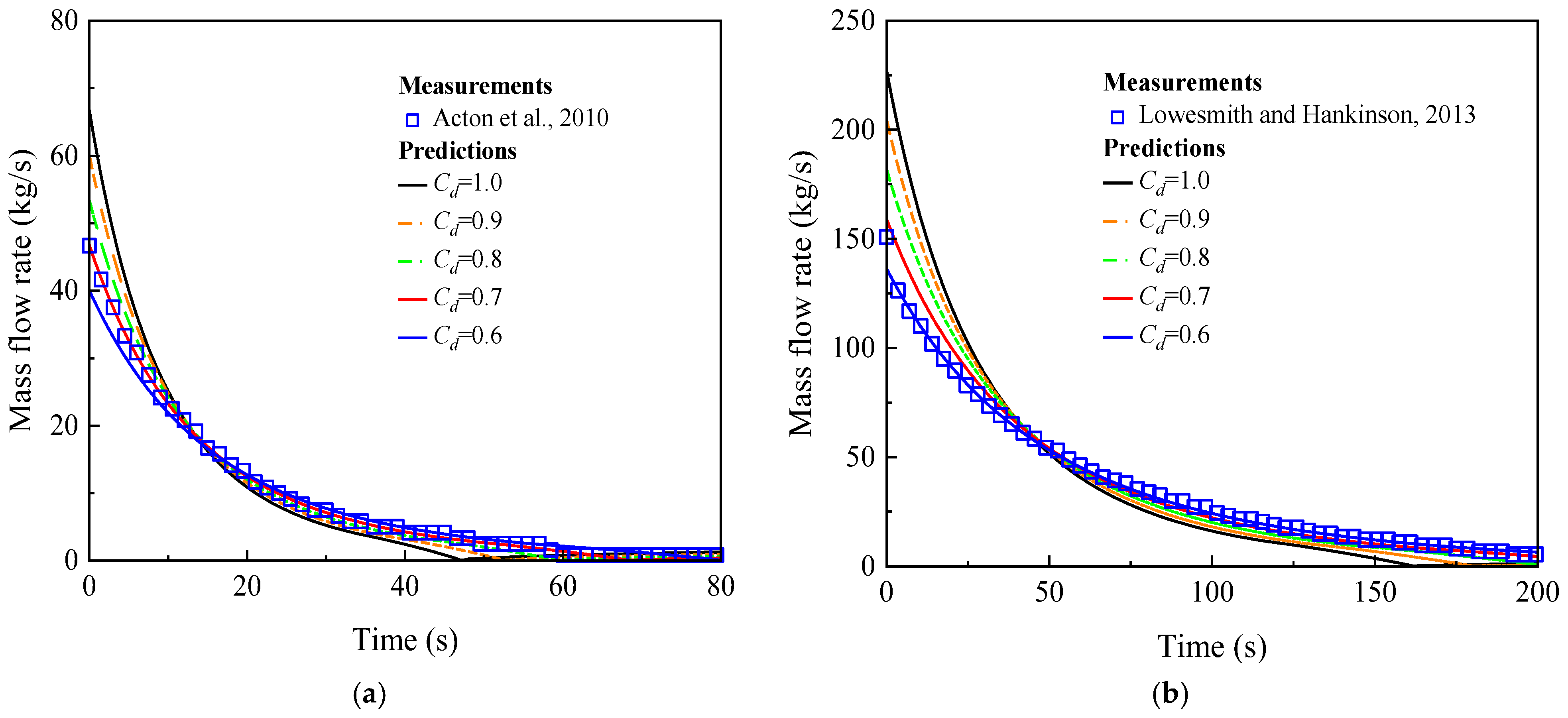



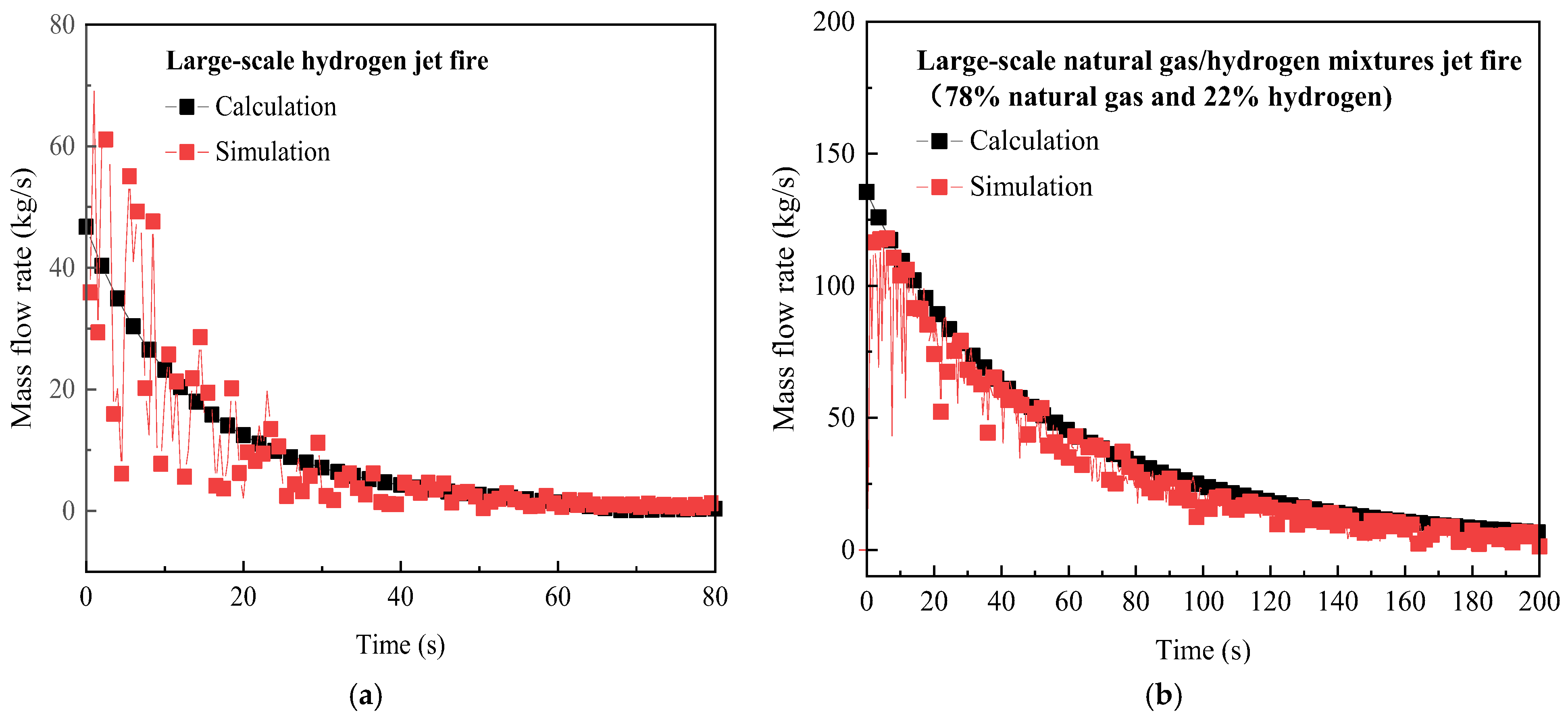



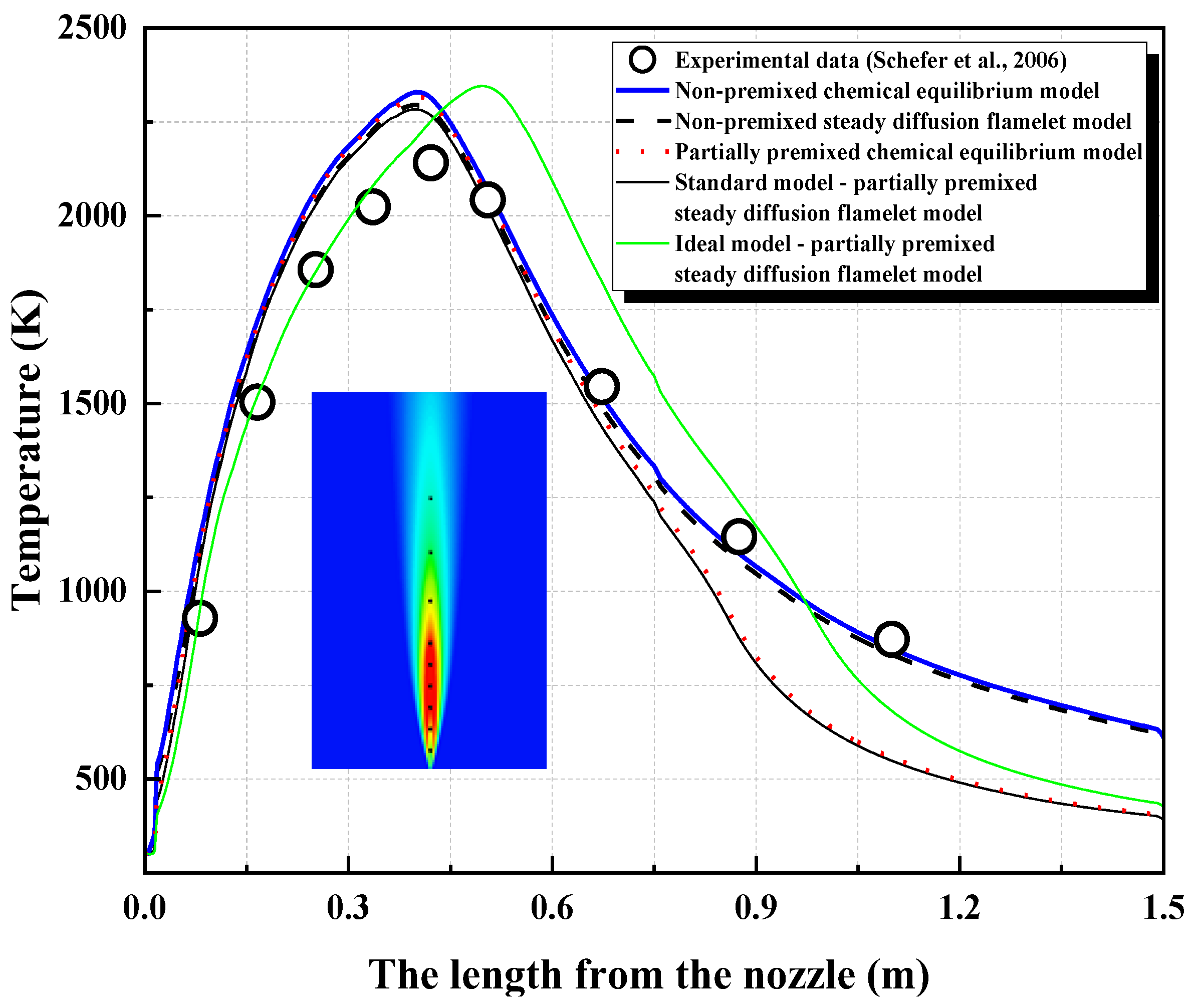
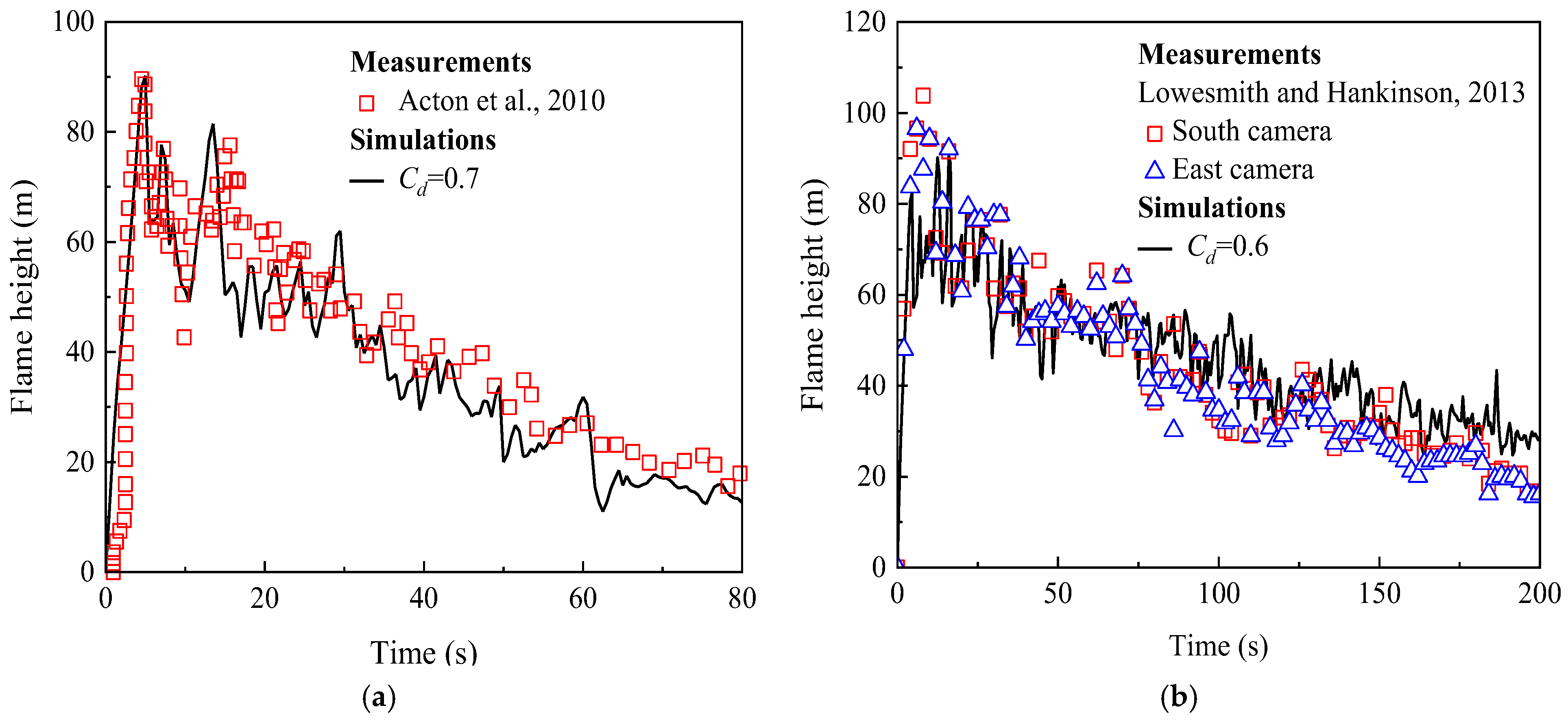
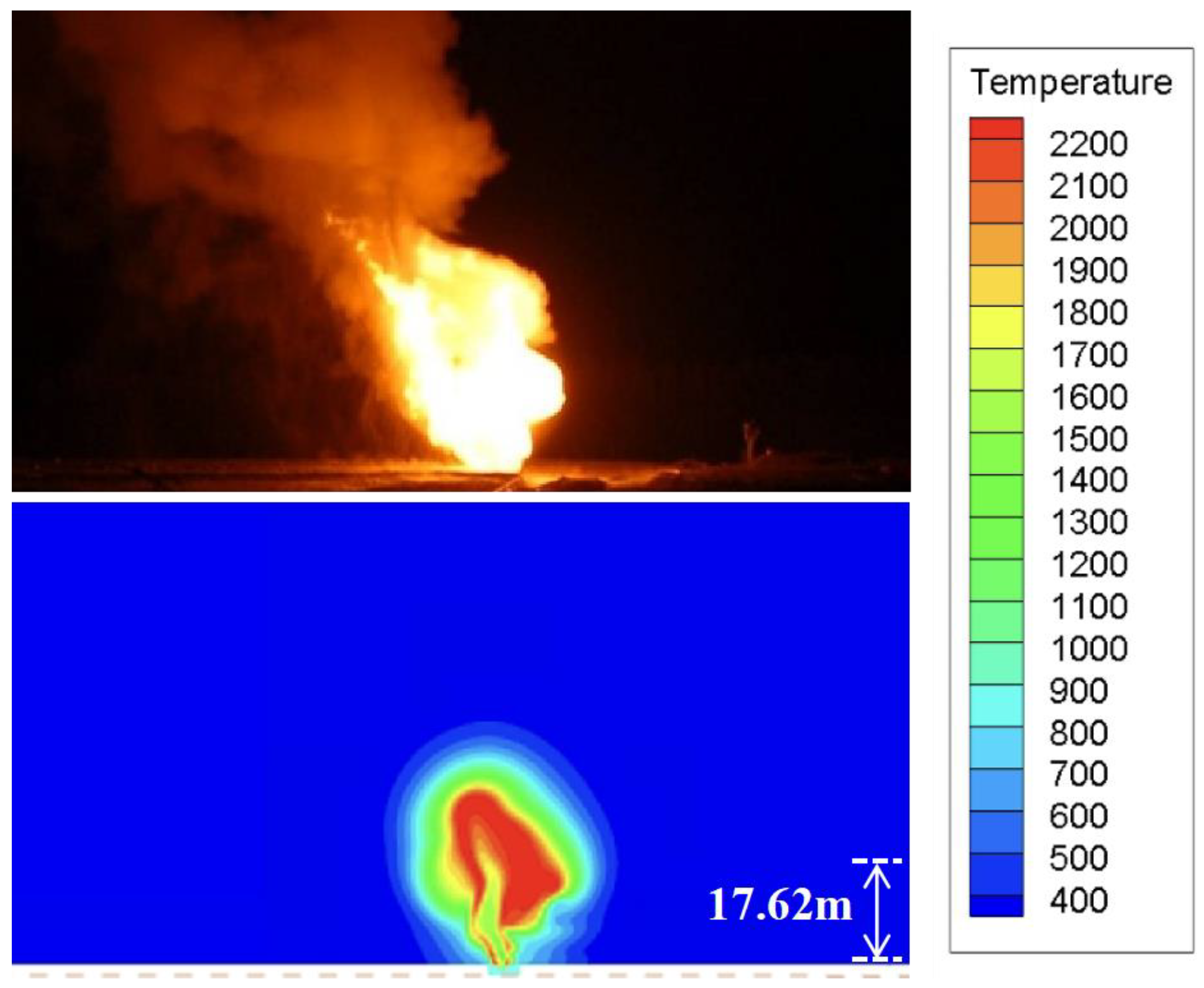

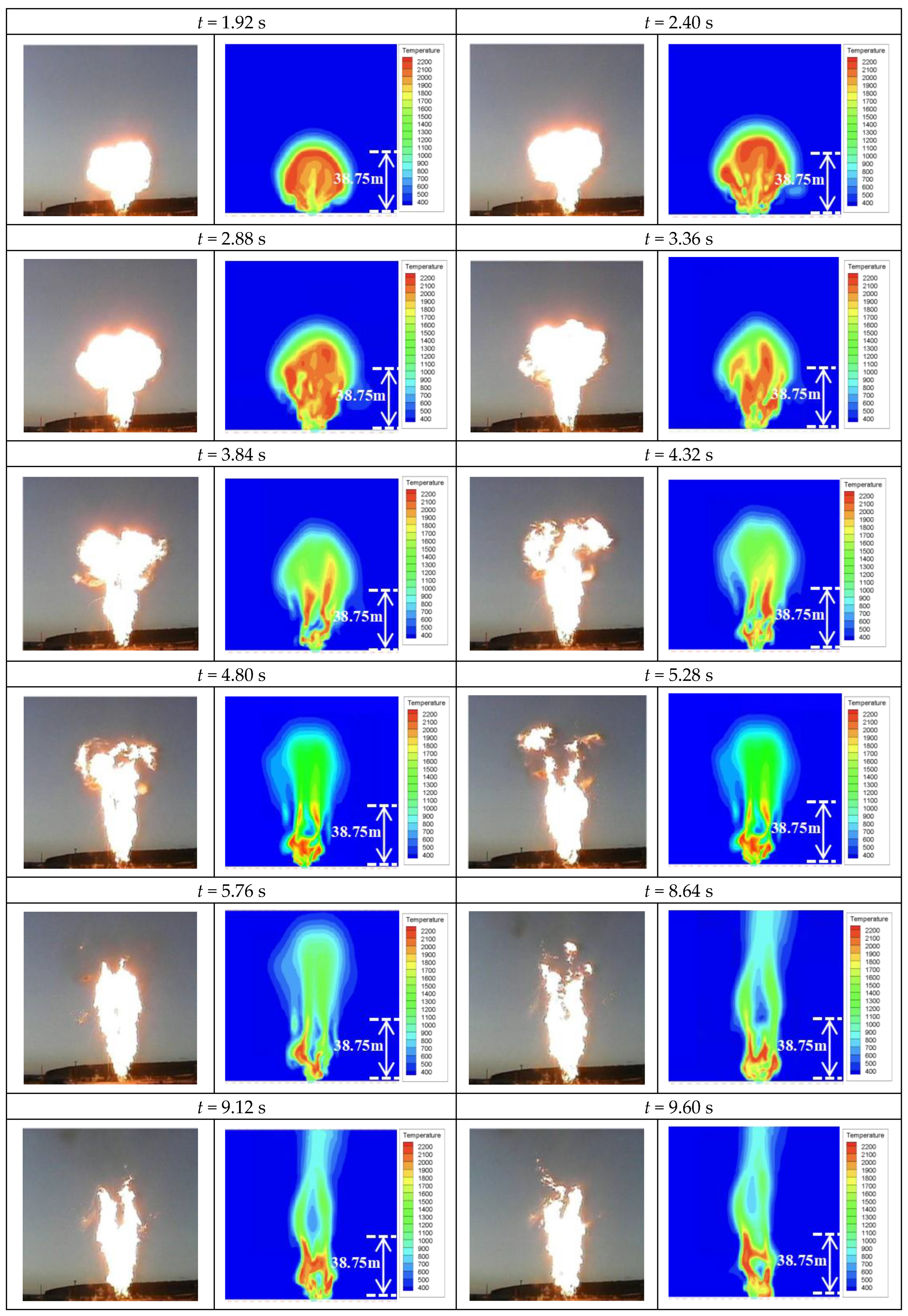
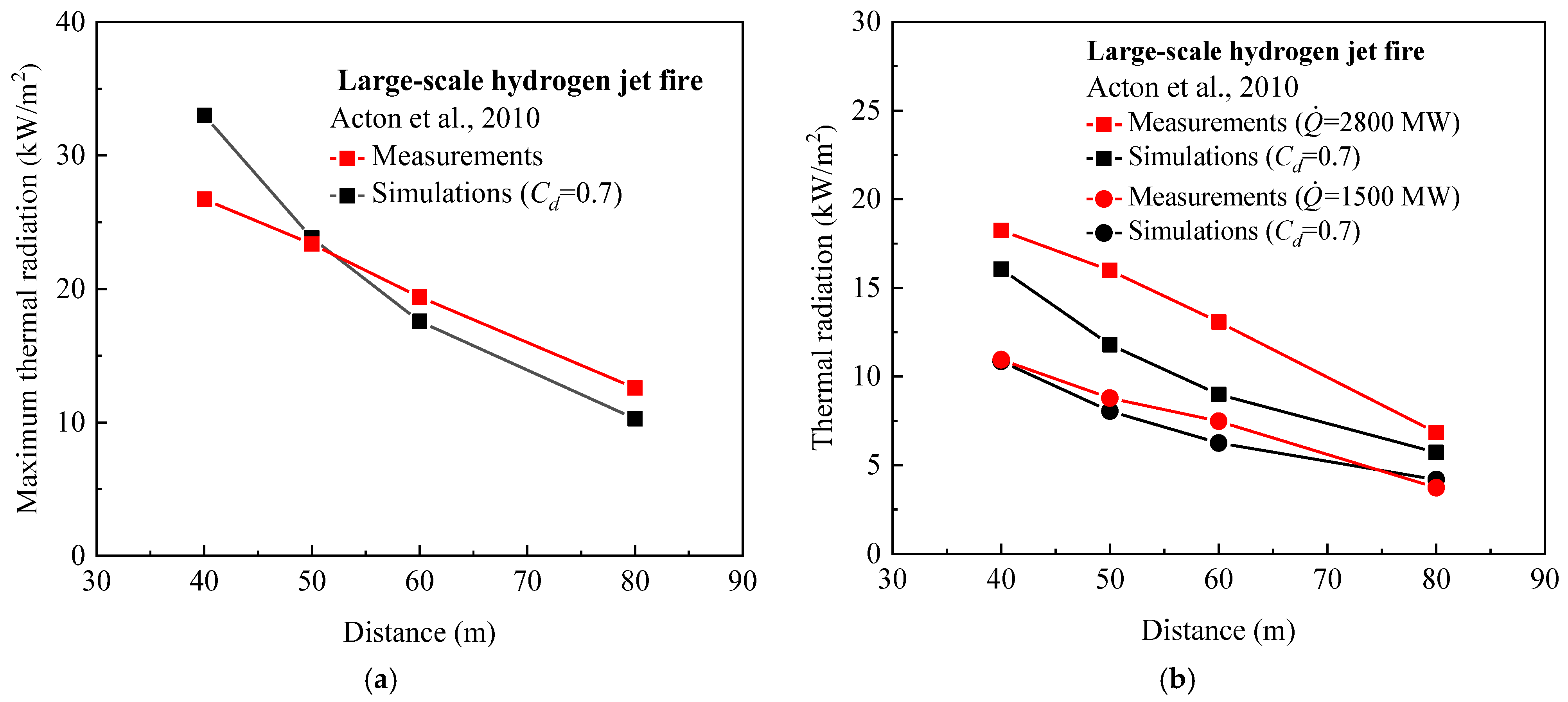
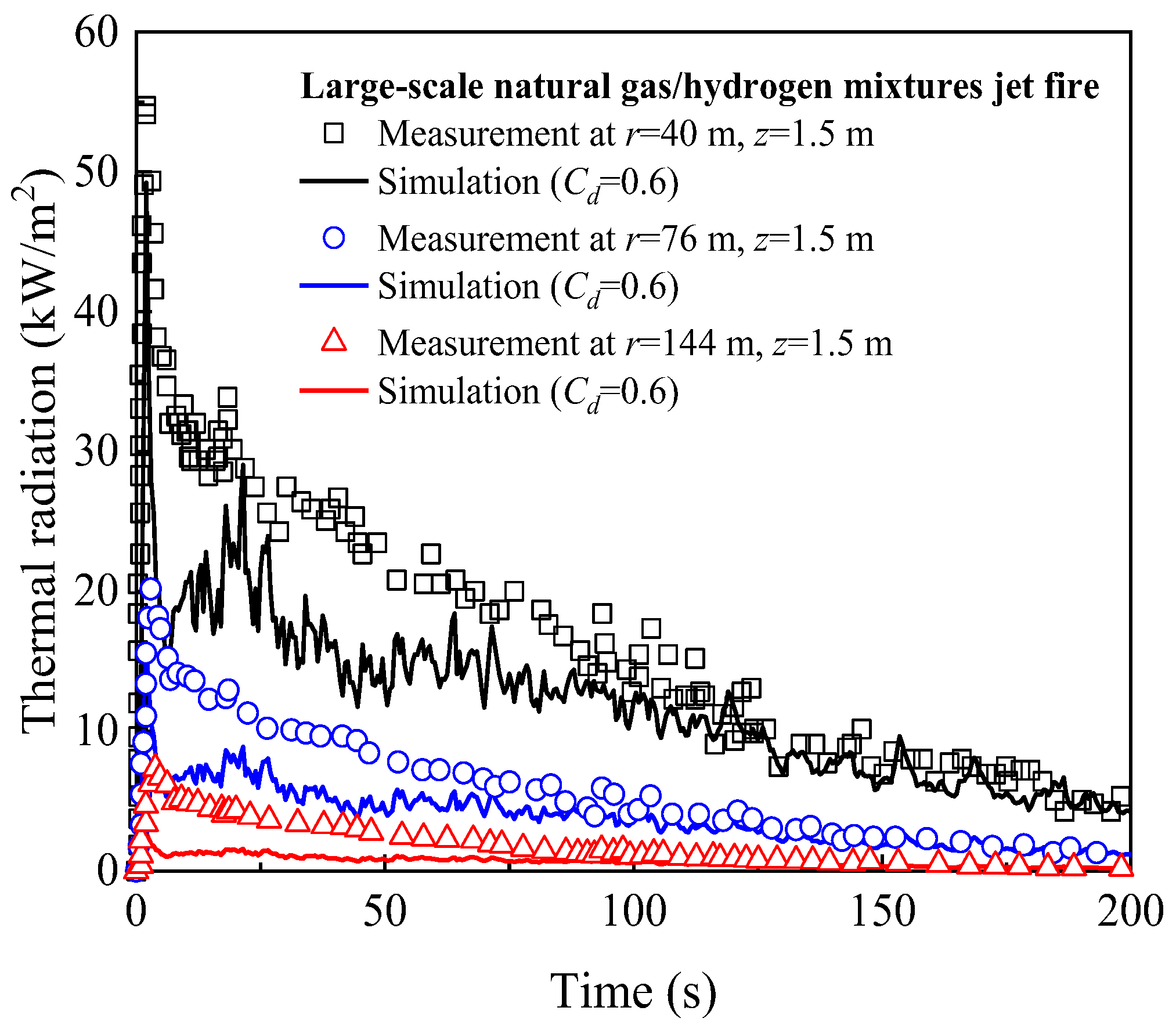

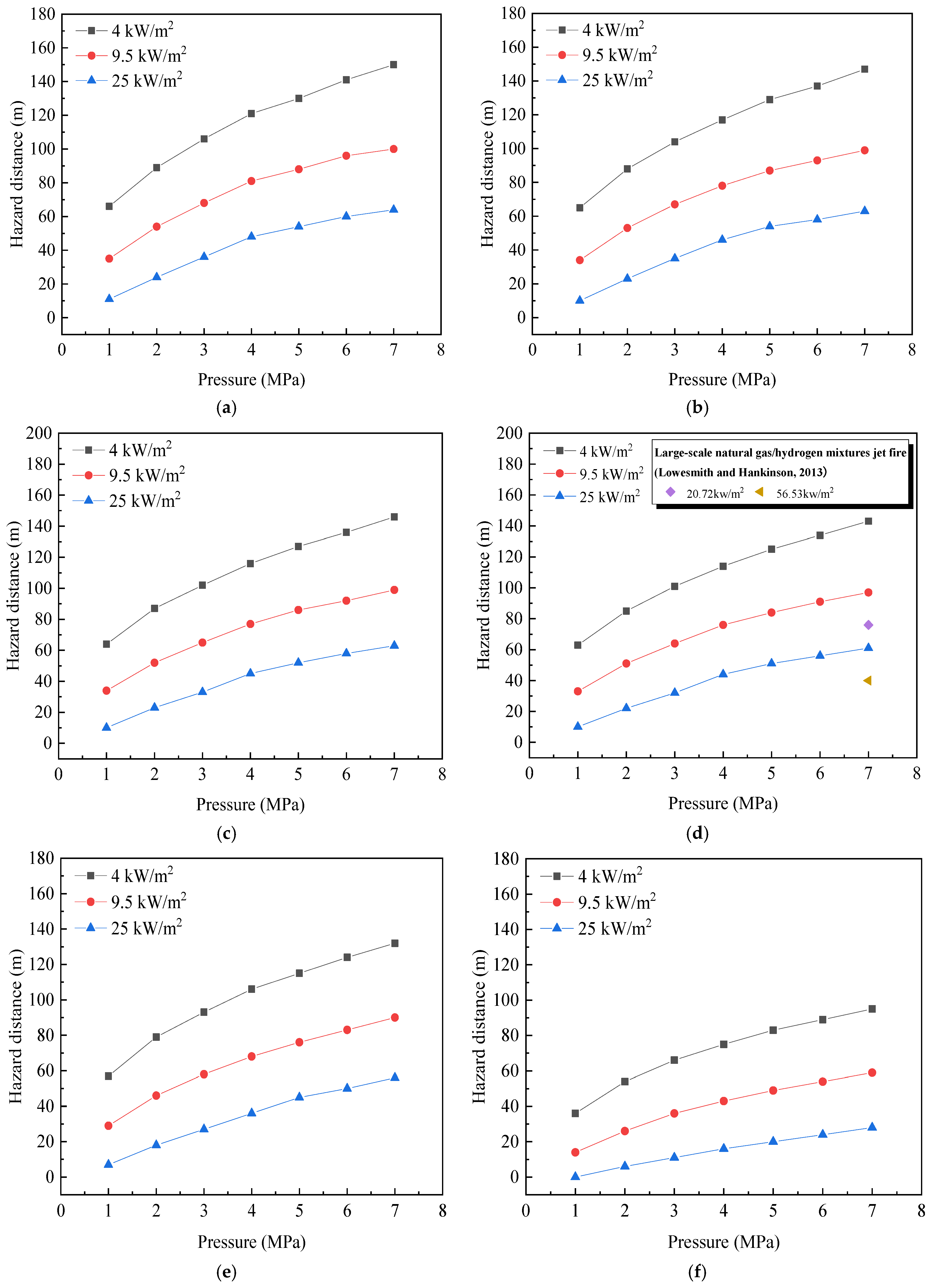
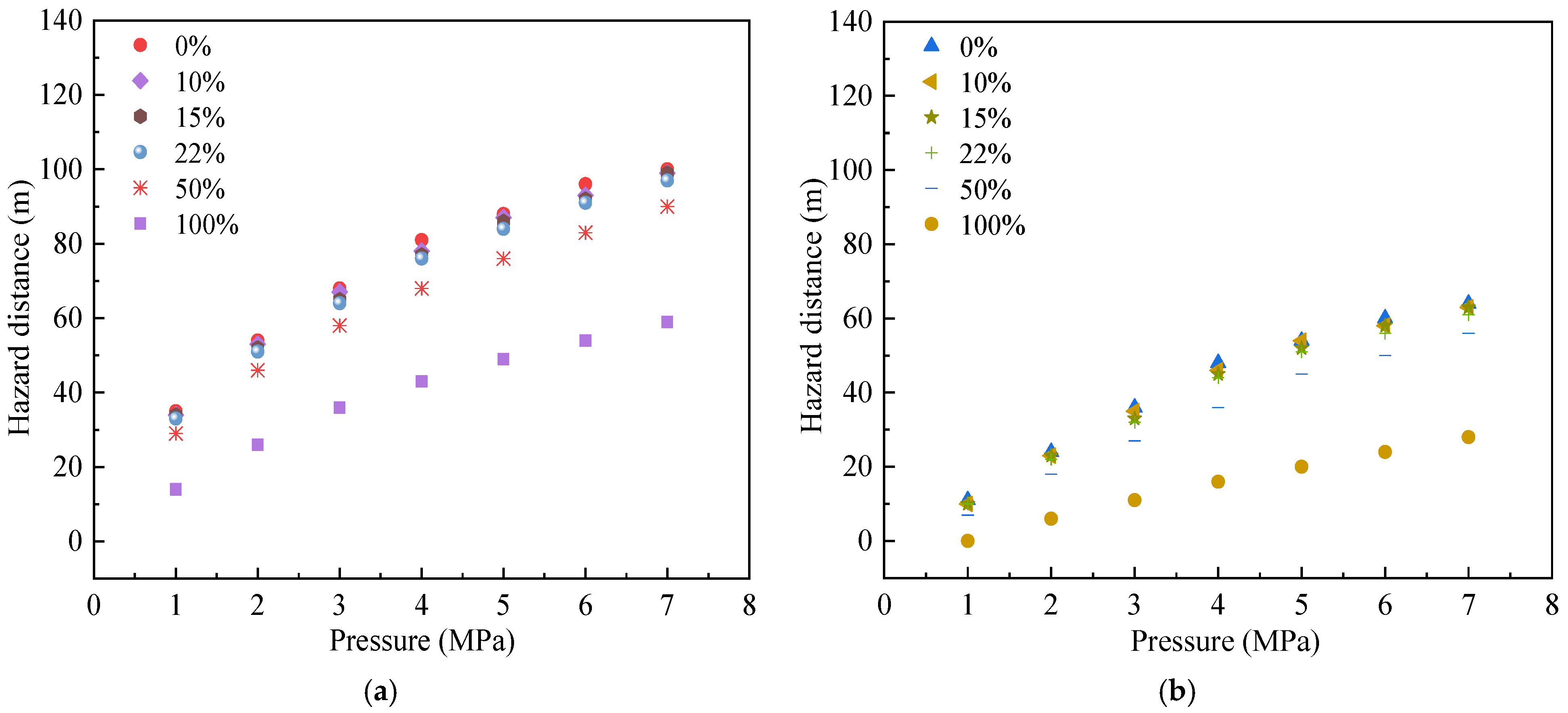
| Experiment | Reference | Gas Composition | Pipe Diameter (m) | Initial Pressure (MPa) | Initial Temperature (K) | Ambient Wind Speed (m/s) |
|---|---|---|---|---|---|---|
| Case 1 | (Acton et al., 2010) [13] | Hydrogen | 0.1524 | 6.1 | 298 | (4–8) a |
| Case 2 | (Lowesmith and Hankinson, 2013) [16] | 78% natural gas and 22% hydrogen | 0.1524 | 7.16 | 277 | (1–2) b |
| Thermal Radiation (kW/m2) | Effect |
|---|---|
| 25 | 100% lethality in 1 min |
| 9.5 | Second-degree burn after 20 s |
| 4 | First-degree burn |
| 1.6 | No harm over long exposure times |
Disclaimer/Publisher’s Note: The statements, opinions and data contained in all publications are solely those of the individual author(s) and contributor(s) and not of MDPI and/or the editor(s). MDPI and/or the editor(s) disclaim responsibility for any injury to people or property resulting from any ideas, methods, instructions or products referred to in the content. |
© 2024 by the authors. Licensee MDPI, Basel, Switzerland. This article is an open access article distributed under the terms and conditions of the Creative Commons Attribution (CC BY) license (https://creativecommons.org/licenses/by/4.0/).
Share and Cite
Li, M.; Wang, Z.; Jiang, J.; Lin, W.; Ni, L.; Pan, Y.; Wang, G. Numerical Simulation and Consequence Analysis of Full-Scale Jet Fires for Pipelines Transporting Pure Hydrogen or Hydrogen Blended with Natural Gas. Fire 2024, 7, 180. https://doi.org/10.3390/fire7060180
Li M, Wang Z, Jiang J, Lin W, Ni L, Pan Y, Wang G. Numerical Simulation and Consequence Analysis of Full-Scale Jet Fires for Pipelines Transporting Pure Hydrogen or Hydrogen Blended with Natural Gas. Fire. 2024; 7(6):180. https://doi.org/10.3390/fire7060180
Chicago/Turabian StyleLi, Meng, Zhenhua Wang, Juncheng Jiang, Wanbing Lin, Lei Ni, Yong Pan, and Guanghu Wang. 2024. "Numerical Simulation and Consequence Analysis of Full-Scale Jet Fires for Pipelines Transporting Pure Hydrogen or Hydrogen Blended with Natural Gas" Fire 7, no. 6: 180. https://doi.org/10.3390/fire7060180
APA StyleLi, M., Wang, Z., Jiang, J., Lin, W., Ni, L., Pan, Y., & Wang, G. (2024). Numerical Simulation and Consequence Analysis of Full-Scale Jet Fires for Pipelines Transporting Pure Hydrogen or Hydrogen Blended with Natural Gas. Fire, 7(6), 180. https://doi.org/10.3390/fire7060180







